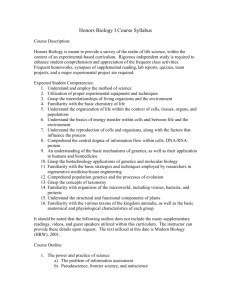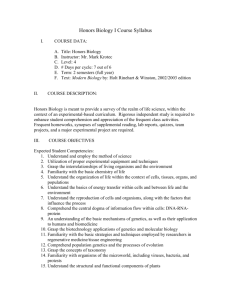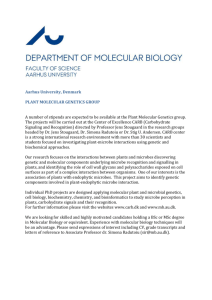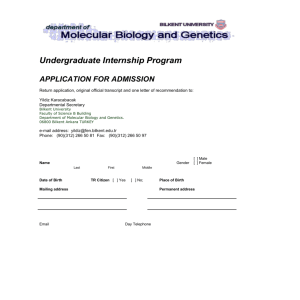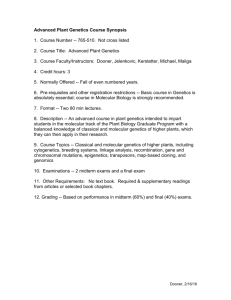LS50 Integrated Science Syllabus pdf
advertisement
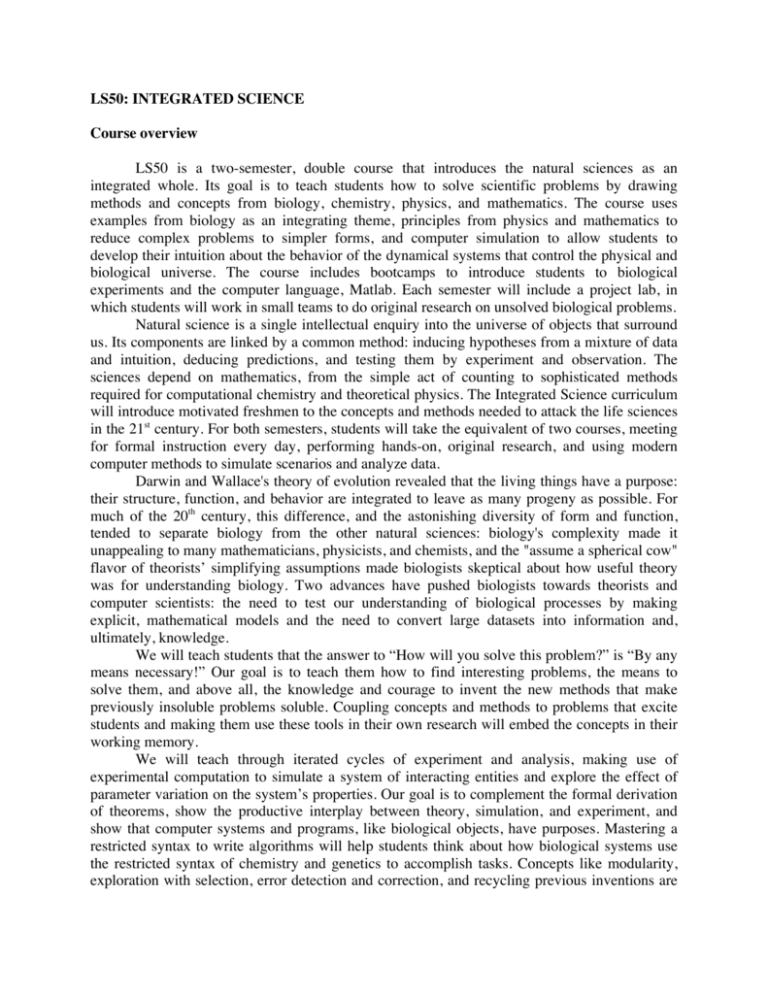
LS50: INTEGRATED SCIENCE Course overview LS50 is a two-semester, double course that introduces the natural sciences as an integrated whole. Its goal is to teach students how to solve scientific problems by drawing methods and concepts from biology, chemistry, physics, and mathematics. The course uses examples from biology as an integrating theme, principles from physics and mathematics to reduce complex problems to simpler forms, and computer simulation to allow students to develop their intuition about the behavior of the dynamical systems that control the physical and biological universe. The course includes bootcamps to introduce students to biological experiments and the computer language, Matlab. Each semester will include a project lab, in which students will work in small teams to do original research on unsolved biological problems. Natural science is a single intellectual enquiry into the universe of objects that surround us. Its components are linked by a common method: inducing hypotheses from a mixture of data and intuition, deducing predictions, and testing them by experiment and observation. The sciences depend on mathematics, from the simple act of counting to sophisticated methods required for computational chemistry and theoretical physics. The Integrated Science curriculum will introduce motivated freshmen to the concepts and methods needed to attack the life sciences in the 21st century. For both semesters, students will take the equivalent of two courses, meeting for formal instruction every day, performing hands-on, original research, and using modern computer methods to simulate scenarios and analyze data. Darwin and Wallace's theory of evolution revealed that the living things have a purpose: their structure, function, and behavior are integrated to leave as many progeny as possible. For much of the 20th century, this difference, and the astonishing diversity of form and function, tended to separate biology from the other natural sciences: biology's complexity made it unappealing to many mathematicians, physicists, and chemists, and the "assume a spherical cow" flavor of theorists’ simplifying assumptions made biologists skeptical about how useful theory was for understanding biology. Two advances have pushed biologists towards theorists and computer scientists: the need to test our understanding of biological processes by making explicit, mathematical models and the need to convert large datasets into information and, ultimately, knowledge. We will teach students that the answer to “How will you solve this problem?” is “By any means necessary!” Our goal is to teach them how to find interesting problems, the means to solve them, and above all, the knowledge and courage to invent the new methods that make previously insoluble problems soluble. Coupling concepts and methods to problems that excite students and making them use these tools in their own research will embed the concepts in their working memory. We will teach through iterated cycles of experiment and analysis, making use of experimental computation to simulate a system of interacting entities and explore the effect of parameter variation on the system’s properties. Our goal is to complement the formal derivation of theorems, show the productive interplay between theory, simulation, and experiment, and show that computer systems and programs, like biological objects, have purposes. Mastering a restricted syntax to write algorithms will help students think about how biological systems use the restricted syntax of chemistry and genetics to accomplish tasks. Concepts like modularity, exploration with selection, error detection and correction, and recycling previous inventions are important in the function and evolution of both organisms and code. Six faculty will teach the course, working as three pairs of one life scientist and one physical scientist. Students will use their knowledge to conduct original scientific research. To ensure that all the students start with abilities in laboratory experiments and computer simulations, we will have two, two week-long boot camps, one in computation and one in experimentation. After the boot camps, students will perform original research in project laboratories. The project labs will be based on the research of and run by the Bauer Fellows, independent scientists who spend five years at Harvard after their PhDs and run small research groups. Class format Daily 1.5 hour lectures. Monday through Friday 10:00 – 11:30 a.m. Weekly conference with teaching fellows. Two, two-week bootcamps: one in programming in Matlab, one in experimental biology Post-bootcamp, research-based laboratory: students work on original research projects in small groups, with open access to a sophisticated modern research laboratory. Students are expected to spend 6 hr/week working on their projects at times that they choose. Faculty Faculty Ben deBivort Michael Desai Cassandra Extavour Erel Levine Andrew Murray Mary Wahl OEB OEB OEB Physics MCB, Course Head Harvard College Fellow The year-long course will be divided into thirds, each team-taught by a pair of faculty, one from the physical and one from the life sciences. Murray will attend all the lectures to ensure continuity. We expect that the intense nature of the course will produce strong interactions both amongst the students and between them and the faculty. Laboratory Heads John Calarco Lauren O'Connell Bauer Fellow Bauer Fellow Each Fellow will be responsible for the research laboratory projects for one semester. Syllabus The list that follows was developed during a single semester Graduate Seminar in Undergraduate Education, in which the six faculty, who will teach the course, and seven graduate students, most of whom will serve as teaching fellows for the course, participated. Since the course will meet every day for two semesters, it will have roughly 125 lectures. As a result the description below is extremely telegraphic, including field-specific words, phrases, and acronyms. To provide more detail, we include detailed descriptions of the materials from three lectures: the opening lecture, the first lecture on probability and inference, and a lecture from roughly a quarter of the way into the course on energy. All three introduce areas, rather than going into areas in depth, since we thought it would be useful for the committee to see material that non-scientists could usefully opine on. For all three, we have provided a one page description of the key material the lecture covers (a roadmap) and the slides. This material is assembled in a single PDF file. Lecture title Introduction & course overview Biology as computation Inferences, Rules, Errors Probability distributions and Bayesian analysis Equilibrium constants and energy diagrams/equilibrium vs. steady-­‐ state Lac operon I: Introduction Lac operon II: Paradigm for gene regulation Quantization, elements, atomic orbitals Periodic trends, molecular orbitals Organic molecules and chirality Protein structure, intermolecular forces Macromolecules and membranes Introduction to ordinary differential equations Dynamical systems I: fixed points and phase plane analysis Introduction to the cell cycle Lecture content What do cells & organisms do to survive & reproduce? The Central Dogma, coding & decoding, sensation & response The scientific method, measurement, measurement & statistical errors Probability distributions, frequentist vs. Bayesian approaches, the Central Limit Theorem Equilibria, on & off rate constants, kinetics, activation energy History, genetics & chemistry, non-­‐genetic individuality via bistability Search times, introduction to 1-­‐D diffusion, modern analysis Atomic models: Bohr, Schrodinger Electronegativity, hybridization, bonds Structure of organic molecules, chirality, complexity Hydrogen and van der Waals bonding, protein structure Sugars, lipids, nucleic acids, membranes, membrane properties What is a differential equation, solutions to simple separable equations, how to code numerical solutions 1-­‐D dynamical systems: fixed points, phase plane analysis Introduction, coordinating growth with division, yeast & embryos Genetic and physiological analysis of the cell cycle Molecular mechanism of the cell cycle DNA replication as an example of a cell cycle-­‐controlled process Cell cycle regulation by external events Cell cycle regulation of events in time and space Electrostatics and Debye screening Math primer: multivariate, Taylor series Many particle systems, approach to equilibrium Equilibrium and entropy Work and heat, energy, free energy Energy budget of the cell Boltzmann statistics Embryonic oscillators vs. yeast dependent event chains, conserved regulators Cell cycle engine mechanism & regulation, cell cycle checkpoints Biology of DNA replication and repair, kinetic proofreading Cell cycle regulation by environmental and developmental inputs Controlling events in time and space, polarization, mitosis Managing backbone electrostatic repulsion during DNA compaction: introduction to electrostatics, Debye screening, nuclear and chromosomal organization Functions of more than one variable, partial derivatives, Taylor series Definitions of system, environment, and entropy; mechanical, chemical, thermal Definition of entropy in terms of multiplicity, intensive vs. extensive variables, equations of state Work and heat; first law of thermodynamics; adiabatic and isothermal processes Magnitude of overall ATP flux and distribution between processes; efficiency Finding extrema under constraints; Lagrange multipliers; the Boltzmann distribution; application to air pressure at altitude Two-­‐state systems Ligand-­‐receptor binding; Schottky; paramagnetism Ideal gas, ideal solid, equipartition Average energy of molecule in a gas; equipartition theorem theorem Law of mass action Specificity: ligand, receptors, homologous recombination Biochemical approach to cooperativity Statistical mechanics approach to cooperativity Reaction rate does not often reflect apparent stoichiometry: relationship between reaction rate and mechanism; rarity of termolecular processes; Arrhenius equation Relative binding energy of correct and incorrect pairings; limitations on accuracy in translation; revisiting lac repressor movement Derivation of Adair equation and Hill curve from expressions for chemical equilibria; MWC and KNF models and their biological motivations Gibbs distribution and grand partition function; application to derive equivalent expressions for cooperativity. Applied to nucleic acid denaturation. Introduction to diffusion Gaussian integrals, convolution, and applications to diffusion Transport in the cell: diffusion, anomalous diffusion, and active transport Diffusion to detection (Berg and Purcell) Lac operon III: Application of rate equations and diffusion; revisiting classic system with modern techniques Molecular implementation of regulation: promoters, activators, repressors, chromatin Synthetic biological circuits Development I: discerning differences between cells Worms fate map (vulva as example) Relationship between potentials and conservative forces; Fick's 1st and 2nd laws; Green's function for Brownian motion Gaussian integrals and calculation of RMS distance traveled, convolution, applications to FRAP and other diffusion problems Detection of crowding/tethering and measurement of diffusion coefficient by FRAP, "speed" of diffusion, need for active transport How many transporters are necessary? Steady-­‐state solution for diffusion of particles towards absorbing regions on a sphere Behavior of the lac operon explained via statistical mechanics, detailed analysis of diffusion and capture of the Lac repressor by the Lac operator How transcription factors and cis-­‐regulatory elements work (bacteria vs. eukaryotes), chromatin modification Design and implementation of synthetic circuits, e.g., genetic switches, repressilator, Collins toggle switch Methods for detecting differences in gene expression between cells, epigenesis vs. predeterminism, overview of metazoan embryology Lineage, fate decisions, and noise in C. elegans vulval development Chemical and phase equilibria Clausius-­‐Clapeyron, surface tension, mixing of hydrophobic molecules and water Phase transitions Solvation, solutions, and mixtures Phase diagrams, metastability, critical point, nucleation of solids Solvation, solutions, osmotic pressures, water and hydrophobicity Electrostatics and the Nernst equation/intra-­‐molecular interactions The superposition principle; ionic bonds, hydrogen bonds, London dispersion forces can all be explained by Coulombic interactions; dipoles and dielectric effect; Bjerrum length calculation Structure I Structure II Structure III Modularity, primary through tertiary structure, turns, domains Self-­‐assembly, Anfinsen, Levinthal, chaperones Driving forces of folding, exploration with selection (MCMC) Introduction to optics Reflection and refraction, Snell's law, lenses and microscopy; diffraction, Bragg's law Fourier transforms Definition of Fourier transform, examples, PSD for shot noise and relation to Poisson statistics, flicker and Brownian noise Diffraction Structure factor and relationship to electron density, diffraction grating demo, methods for phase determination X-­‐ray crystallography and EM Interpretation of photo 51, introduction to EM Membranes, permeability, and pumps Energy harvesting in photosynthesis Chemiosmotic hypothesis Lipid structure, surface tension and surfactants, permeability, partition coefficients, pumps and channels Introduction to photosynthesis with emphasis on light-­‐dependent steps; production of proton gradient and ATP synthesis by relieving confinement. Mitochondria, oxidative phosphorylation, generation of heat from brown fat, decoupling weight loss aids Carbon fixation and consumption Enzymes I Enzymes II Enzymes III Remaining steps of photosynthesis and glycolysis discussed Measurement, catalysis, local concentration Rate equations, separation of timescales, Michaelis-­‐Menten kinetics Orientation, arrow pushing, covalent intermediates Two-­‐component signaling Introduction to signaling, crosstalk avoidance, arrow-­‐pushing mechanism of HK-­‐RR phosphotransfer Linear algebra I Vectors, scalars, vector space, dimensionality, component representation, matrices Linear algebra II Linear algebra III Linear algebra IV Matrix multiplication, identity operator, and inverse Change of basis, orthogonality Eigenvalues and eigenvectors Principal Component Analysis (PCA) PCA application I: facial recognition PCA application II: microbial communities Newton’s laws of motion Simple harmonic motion Soft matter springs Conservation laws I Conservation laws II Changing basis in a meaningful way, dimensionality reduction, application to genetic variation in Europeans Damped harmonic motion Driven harmonic motion Systems of harmonic equations Examples of systems of harmonic equations Motors and polarity PCA applied to facial recognition PCA applied to microbial communities, discussion of clustering methods F=ma, second order differential equations, simple examples Harmonic equation, solutions to this equation, ball on a spring. Elasticity and entropic string Energy and momentum Example problems Damped harmonic equation, overdamped and underdamped solutions Driven harmonic equation, solution, resonance Normal modes of a system of harmonic equations Coupled balls on a string, coupled pendulums, applications to modes of molecular oscillations Directional motion of motors along polymers, dynein, sarcomere cycle Thermodynamic cycles and molecular motor efficiency Carnot cycle, calculation of efficiency of ATP synthase motor, Brownian ratchets and directed motion Cytoskeleton I Cytoskeleton II Basics, polymerization, critical concentration, spindle assembly Non-­‐equilibrium polymers Pros and cons of putting different activities in different compartments Cyanobacterial/alpha-­‐proteobacterial origin of the chloroplast/mitochondrion, gradual gene transfer, non-­‐Mendelian inheritance Nuclear transport, protein secretion Segregation Endosymbiont theory Import and export Symmetry and symmetry breaking Symmetry as invariance under transformation, CP violation and CPT symmetry, lateral inhibition and bud site determination A-­‐P axis patterning in Drosophila embryo, maternal Development II effect/gap/segment polarity genes, morphogens, useful transgenic techniques Bifurcations; examples possibly including spruce budworm, firefly Dynamical systems II flashing, homochirality Two-­‐dimensional dynamical systems, classifying fixed points, spiral Dynamical systems III nodes Dynamical systems IV Limit cycles, Lotka-­‐Volterra, Poincare-­‐Bendixson Membrane potentials, chemical synapses, gap junctions, calcium Introduction to neuroscience compartments Hodgkin and Huxley Hodgkin-­‐Huxley model in neuroscience, solutions by simulations. Optogenetics, behavioral feedback Using light to control neural activity and probe the function of loops nervous systems Pattern recognition, inhibitory-­‐excitatory alternation, Locomotion proprioception, efference copy Stochastic processes: from Formalizing random walks as a Markov chain, basic properties of random walks to Markov chains Markov chains Langevin equation for a stochastic process, interpretations, Stochastic differential equations simulations Biological examples of Mutation, excitability, plasmid partition stochasticity Master equation, birth-­‐death Using matrices to model the temporal evolution of complex systems processes Noise in molecular biology Stochasticity of gene expression, neuronal activity Graphs as formal devices to represent connections within complex Graph theory systems. Examples from control of neuronal activity and gene expression. Network theory Analysis of the structures and properties of large networks. Worms II Metabolic networks Social interactions Classical genetics Molecular genetics I Molecular genetics II Genomics Evolutionary relationships Origin of life History of terrestrial biology and chemistry Diversity of life Population genetics I Population genetics II Population genetics III Population genetics IV Evolutionary thinking Molecular evolution of proteins Connectome, EM reconstruction, network properties Metabolism as a dynamical system, flux balance analysis Origins of complex behaviors (e.g. flocking) from simple rules Genes, alleles, sex, meiosis, mapping, screens Mutant selection, epistasis, chromosome elements, manipulation Diploids, transgenesis, CRISPR Sequencing, assembly, homology, BLAST Phylogenetics, orthology, paralogy Origin of life, RNA world History of life on earth, mass extinctions, major transitions in evolution Diversity of life, strange phyla Mutations and the origin and maintenance of diversity, selection, drift Sex: meiosis, sexual selection, Muller’s ratchet Speciation and adaptive radiations Detecting selection: MK, extended haplotype tests, bulk segregant/QTL Drift, modification, recycling with modification, modularity Evolution of protein function, extracting information from covariation Evolution of development Regulatory vs. coding region evolution, interpretation of heterologous expression experiments in Drosophilids, QTL applied to sticklebacks, duplication and divergence in coding regions Diversifying mechanisms Diversity inducing mech., contingency loci, switches, non genet individuality Assessment Assessment will be based on five criteria: In-class tests We will administer biweekly, in-class tests. These will cover the same material as weekly, ungraded problem sets, and for each test, one of the problems on the test will be a verbatim reproduction of one of the questions from each of the two problem sets. This provides incentive for students to work on the problem sets, but removes the need for formal policies on collaboration since the problem sets are not graded. Final exams Since this is a double class, we will administer two, three-hour finals in each semester. For each the goal will be that well-prepared students should be able to complete the final in two hours and questions will focus on solving problems (mathematical analysis of problems, data interpretation, and experimental design), rather than regurgitation. A research proposal Students will produce and orally defend a 5-page research proposal. Since we expect that most students will do research in the summer that ends their freshman year, this proposal and the feedback it produces will be useful for research they actually perform. Laboratory research projects Students will be graded on the research projects they undertake, focusing on their ability to design and interpret experiments and their commitment to and engagement with their research more than on the quality of the results they produce (subject as these are to the whims of the Gods). Participation Students will be graded on their participation in class, which we expect to be highly interactive, weekly conferences, and the discussions associated with laboratory research. These criteria will be accorded the following weights In-class tests Final exams Research proposal Laboratory research Participation 25% 25% 20% 20% 10%

